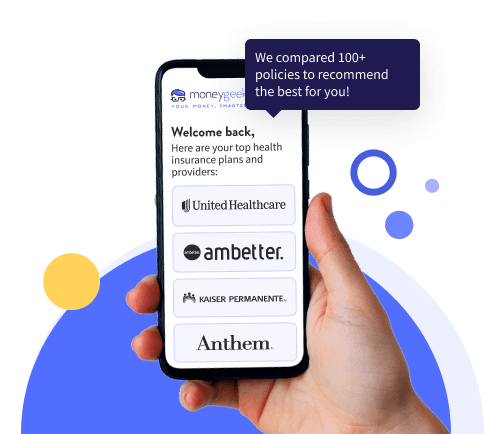At 65, you're looking at around $189 monthly for Medigap on average. By 75, that's jumped to $238, almost $600 more per year just from getting older. Here's what we discovered when we looked at different plans: high-deductible options start at $61 monthly, but you'll shell out $2,870 before coverage begins. Plan G costs about $220 per month and picks up most of what Medicare doesn't pay. What you'll actually pay comes down to your location and insurer, rates for identical coverage can differ by hundreds of dollars between companies.
Medicare Supplement Plans (Medigap) Cost: 2026 Plan Year
Medicare Supplement plans cost range from $61 to $354 monthly depending on your age, state and coverage level. Identical plans can differ by hundreds between insurers.
Explore how premiums vary by state and plan type below.

Updated: November 13, 2025
Advertising & Editorial Disclosure
Medicare Supplement costs average $189 monthly at 65, increasing to $238 by age 75.
Your total costs include monthly premiums, usually the $257 Part B deductible and potential copays or cost-sharing.
Comparing multiple insurers during Open Enrollment can save you $50 to $100 monthly on identical coverage.
How Much Does Medicare Supplement Cost?
Medigap $20 & $50 Copay Plan | Pays most Medicare out-of-pocket costs with small copays for office and emergency room visits | $206 | $206 |
Medigap Plan A | Covers basic benefits including Part A coinsurance and hospital costs | $213 | $266 |
Medigap Plan B | Includes Plan A benefits plus Part A deductible coverage | $257 | $324 |
Medigap Plan C | Offers comprehensive coverage including Part B deductible and foreign travel emergency care | $294 | $381 |
Medigap Plan D | Provides Plan A benefits plus Part A deductible and foreign travel emergency care | $225 | $306 |
Medigap Plan F | Most comprehensive coverage including all deductibles and coinsurance | $271 | $342 |
Medigap Plan F High Deductible | Same as Plan F but with lower premiums and a high annual deductible you pay first | $66 | $85 |
Medigap Plan G | Nearly identical to Plan F but doesn't cover the Part B deductible | $220 | $279 |
Medigap Plan G High Deductible | Same as Plan G with lower premiums and a high annual deductible | $61 | $79 |
Medigap Plan K | Covers 50% of most costs with lower premiums and an annual out-of-pocket limit | $110 | $139 |
Medigap Plan L | Covers 75% of most costs with an annual out-of-pocket limit | $179 | $226 |
Medigap Plan M | Covers 50% of Part A deductible and includes foreign travel emergency care | $185 | $239 |
Medigap Plan N | Requires copays for office and emergency room visits but offers lower premiums | $171 | $221 |
Costs shown represent national average monthly premiums based on MoneyGeek's analysis of Medigap plans. Your actual premium may vary based on your location, insurance company, rating method and health status. Plans C and F are only available to those who became eligible for Medicare before January 1, 2020.
Medicare Supplement Cost by State
Where you live makes a massive difference in what you'll pay for Medigap. We've checked prices in every single state and Washington, D.C., and found premiums vary by more than $190 monthly for the same coverage. New York leads at $354 per month for both ages, while South Carolina and New Mexico offer the lowest rates at $160 for 65-year-olds. Some states, like Massachusetts and Washington, keep prices flat regardless of age, but most states charge more as you get older. Take a look at your state below and you might save hundreds by comparing insurers in your area.
Alabama | $180 | $237 |
Alaska | $180 | $250 |
Arizona | $217 | $279 |
Arkansas | $205 | $205 |
California | $195 | $280 |
Colorado | $200 | $262 |
Connecticut | $309 | $309 |
Delaware | $181 | $242 |
Florida | $320 | $396 |
Georgia | $200 | $249 |
Hawaii | $180 | $248 |
Idaho | $214 | $214 |
Illinois | $202 | $267 |
Indiana | $183 | $242 |
Iowa | $174 | $229 |
Kansas | $191 | $247 |
Kentucky | $197 | $259 |
Louisiana | $183 | $242 |
Maine | $240 | $238 |
Maryland | $258 | $342 |
Massachusetts | $215 | $215 |
Michigan | $200 | $271 |
Minnesota | $254 | $254 |
Mississippi | $177 | $234 |
Missouri | $232 | $306 |
Montana | $180 | $243 |
Nebraska | $198 | $260 |
Nevada | $221 | $301 |
New Hampshire | $221 | $289 |
New Jersey | $206 | $251 |
New Mexico | $160 | $214 |
New York | $354 | $354 |
North Carolina | $169 | $222 |
North Dakota | $174 | $241 |
Ohio | $180 | $234 |
Oklahoma | $207 | $281 |
Oregon | $242 | $285 |
Pennsylvania | $214 | $274 |
Rhode Island | $185 | $258 |
South Carolina | $160 | $210 |
South Dakota | $194 | $262 |
Tennessee | $175 | $228 |
Texas | $200 | $264 |
Utah | $169 | $232 |
Vermont | $234 | $236 |
Virginia | $192 | $248 |
Washington | $225 | $225 |
West Virginia | $175 | $237 |
Wisconsin | $186 | $243 |
Wyoming | $197 | $266 |
Washington D.C. | $212 | $280 |
Costs shown represent average monthly premiums based on MoneyGeek's analysis of Medigap plans in each state. Some states regulate pricing methods, which affects how premiums increase with age.
Medicare Supplement Costs Breakdown
Medicare costs get confusing when you're trying to figure out your budget. You want to know exactly what you'll pay each month. Medigap adds monthly expenses on top of what you already pay for Medicare, but knowing these costs upfront helps you pick the right plan and avoid surprises.
The amounts shown reflect current Medicare standards and are subject to annual adjustments. The information provided is for educational purposes only and should not replace personalized advice from a licensed insurance professional.
- Community-rated (no-age-rated): Everyone pays the same premium regardless of age. Your rate increases only due to inflation or other factors affecting all policyholders.
- Issue-age-rated (entry-age-rated): Your premium depends on your age when you first buy the policy. Your rate stays lower over time compared to attained-age pricing, though it can still increase for inflation.
- Attained-age-rated: Your premium increases as you get older. This pricing starts lower than other methods but typically becomes more expensive over time.
- Plan N Copays: Plan N charges copays up to $20 for doctor visits and up to $50 for emergency room visits that don't result in admission. You pay these amounts each time you use these services, even after meeting your Part B deductible. If you face unexpected claim denials, knowing your appeal rights matters.
- Plans K and L Cost-Sharing: These plans split Medicare-approved costs with you until you reach an annual limit. Plan K covers 50% of costs, capping your out-of-pocket expenses at $7,060 in 2025. Plan L covers 75% of costs with a $3,530 maximum out-of-pocket limit for 2025.
- Part D Prescription Coverage: Medigap plans don't include prescription drug coverage. You need a separate Medicare Part D plan, which typically costs $20 to $80 monthly depending on your chosen plan and location.
- Foreign Travel Emergency Coverage: Most Medigap plans cover 80% of emergency care during foreign travel after you meet a $250 deductible. Your lifetime maximum for this benefit is $50,000.
Your monthly Medigap premium goes directly to your private insurance company and covers the gaps in Original Medicare. This premium stays separate from your Medicare Part B premium, which you continue paying to the federal government. Medigap acts as secondary insurance, coordinating with Medicare to cover costs Original Medicare doesn't fully pay.
Insurance companies calculate your premium using one of three pricing methods:
The Medicare Part B deductible stands at $257 for 2025. You pay this amount each year before Original Medicare coverage begins. Most Medigap plans don't cover this deductible, but Plan C and Plan F do cover it. You can only purchase these plans if you qualify for Medicare before January 1, 2020.
High-deductible versions of Plan G require you to pay $2,875 out-of-pocket in 2025 before your supplemental coverage starts. This amount covers all Medicare-approved costs, including the Part B deductible. Once you meet this threshold, the plan pays 100% of covered services for the rest of the calendar year.
Beyond monthly premiums and deductibles, you might have to bear additional costs in some cases:
Your Medigap premium isn't random. Insurance companies look at specific things when they calculate what you'll pay each month. Here's what actually affects your monthly payment:
- Your age matters, especially with attained-age pricing. Your premium goes up each year on your birthday in most states.
- Where you live changes your rate; cities with lots of insurance companies competing for business usually have lower premiums than rural areas with fewer options.
- Tobacco use costs you. Most states let insurers charge tobacco users up to 50% more, though some states limit or ban these surcharges.
- The plan you pick affects your cost. Plan G costs more than Plan N because it covers more services without copays.
- The insurance company you choose makes a big difference. Companies charge different amounts for identical coverage, which is why shopping around matters.
How Can You Save On Medicare Supplement (Medigap) Costs
Nobody wants to overpay for Medigap. A little homework up front can save you serious money each year without giving up coverage you need. Shopping during open enrollment through the marketplace, so that no insurance company can deny you or ask about discounts that can lower your costs. Let’s look at some of these options in detail:
- 1Shop During Your Open Enrollment Period
Your six-month Medigap Open Enrollment Period starts when you turn 65 and enroll in Medicare Part B. Insurance companies can't reject you or charge more based on your health during this window. Miss it and insurers can look at your medical history, charge you more or turn you down entirely. Additionally, if you're retiring early, you'll need health insurance coverage before you turn 65 since you can't enroll in Medicare yet.
- 2Compare Multiple Insurance Companies
Here's the thing: Medigap plans work the same way no matter who sells them. Plan G from State Farm covers the exact same things as Plan G from Mutual of Omaha. Yet premiums can differ by $50 to $100 per month between companies. Get quotes from at least three insurers before you buy.
- 3Consider High-Deductible Options
High-deductible Plan G costs much less each month than standard Plan G. This works well if you don't see doctors often and have $2,875 in savings to cover the deductible. Add up what you usually spend on health care each year to see if the lower monthly premium is worth the higher deductible.
- 4Review Your Plan Annually
Your health needs change. Your budget changes. Look at your Medigap coverage each year during the Medicare Annual Enrollment Period to make sure it still works for you. You can switch plans anytime, though insurers may check your health if you're outside your initial enrollment period.
- 5Ask About Available Discounts
Many insurers offer discounts that can lower your monthly premium. Common discounts include household discounts for couples, automatic payment discounts, non-tobacco discounts and prior insurance discounts. Ask your insurer which discounts you qualify for.
Many insurers cut your monthly premium when you qualify for discounts:
- Household discount: You and your spouse both buy policies from the same company and save.
- Automatic payment discount: Set up automatic bank withdrawals and get a small premium reduction.
- Non-tobacco discount: Make sure you're getting the full non-tobacco rate if you don't use tobacco.
- Prior insurance discount: Some companies lower premiums if you keep continuous health coverage before enrolling in Medigap.
Bottom Line
Medicare Supplement costs start around $189 monthly at 65 and climb as you age. Your location, tobacco use and chosen insurance company all affect your premium. Beyond monthly payments, budget for the $257 Part B deductible plus any plan-specific copays. Smart shopping makes a difference: comparing insurers during your Open Enrollment Period can cut your monthly costs by $50 to $100 for the same coverage.
Cost of Medicare Supplement Plans: FAQ
We've answered the most frequently asked questions about Medicare Supplement plan costs to help you budget for coverage:
Do Medicare Supplement premiums increase every year?
Your premiums can increase annually due to inflation and rising health care costs, regardless of pricing method. Attained-age-rated policies also increase on your birthday. Community-rated and issue-age-rated plans don't increase based on age but still adjust for inflation and claims experience.
What's the cheapest Medicare Supplement plan?
High-deductible Plan G costs the least at $61 monthly for 65-year-olds, but you'll pay $2,875 out-of-pocket before coverage starts. Plan K offers the next-lowest premium at $110 monthly but only covers 50% of costs. Compare your expected health care expenses against premium savings to find your best value.
Can you switch Medicare Supplement plans to save money?
You can switch Medigap plans anytime, but insurers may check your health and charge more or deny coverage outside your initial enrollment period. Comparing plans can save $50 to $100 monthly on identical coverage. Some states offer additional enrollment rights that protect you during certain life events.
What costs does Medicare Supplement not cover?
Medigap doesn't cover prescription drugs, dental care, vision services, hearing aids, or long-term care. You'll need a separate Part D plan for prescriptions, costing $20 to $80 monthly. Foreign travel emergency coverage caps at $50,000 lifetime and requires a $250 deductible. Medicare Advantage plans often bundle these benefits if you prefer an all-in-one approach.
Is a high-deductible Plan G worth it?
High-deductible Plan G saves you $1,908 annually in premiums compared to standard Plan G ($61 versus $220 monthly at age 65). You'll come out ahead if your annual health care costs stay under $4,783 ($1,908 in premium savings plus the $2,875 deductible you'd pay).
How We Calculated the Medicare Supplement Plans Cost
Medicare Supplement (Medigap) costs change as you age, so we collected quotes for beneficiaries at age 65 and age 75 to show you how premiums increase over time and help you budget for coverage throughout retirement.
Our Research Approach
We gathered 16,954 quotes from Medicare.gov, covering all available Medigap plan types in each state. This dataset shows what standardized Medicare Supplement plans actually cost across the country for the 2026 plan year, giving you realistic pricing expectations whether you're newly eligible or already enrolled.
Why We Analyzed Two Age Groups
Your age directly affects Medigap premiums. Most insurers use attained-age pricing, meaning your premium increases as you get older. By comparing costs at age 65 (when most people first enroll) and age 75 (a decade into retirement), you can see how your budget needs will change over time. This helps you choose plans you can afford now and in the future.
Plan Types Covered
We analyzed all standardized Medigap plans available in each state:
- Plan A – Basic coverage
- Plan B – Includes Part A deductible
- Plan C – No longer sold to new enrollees (legacy plans only)
- Plan D – Part A deductible plus some skilled nursing
- Plan F – Most comprehensive (legacy plans only)
- Plan G – Most popular current option
- Plan K – Lower premiums with cost-sharing
- Plan L – Moderate premiums with partial cost-sharing
- Plan M – Part A deductible cost-sharing
- Plan N – Lower premiums with copay
State-Specific Plan Systems
Massachusetts, Minnesota and Wisconsin don't use the standard plan letters. These states created their own unique plan names and benefit structures before federal standardization. If you live in one of these states, you'll see different plan options than the lettered plans available elsewhere.
What the Numbers Mean for You
Medigap plans with the same letter offer identical benefits regardless of which insurer sells them. Plan G from one insurer covers the exact same expenses as Plan G from another. The only difference is price, which makes comparing costs straightforward once you decide which coverage level fits your needs.
Related Articles
About Mark Fitzpatrick

Mark Fitzpatrick, a Licensed Property and Casualty Insurance Producer, is MoneyGeek's resident Personal Finance Expert. With over five years of experience analyzing the insurance market, he conducts original research and creates tailored content for all types of buyers. His insights have been featured in publications like CNBC, NBC News and Mashable.
Fitzpatrick holds a master’s degree in economics and international relations from Johns Hopkins University and a bachelor’s degree from Boston College. He's also a five-time Jeopardy champion!
He writes about economics and insurance, breaking down complex topics so people know what they're buying.
sources
- Medicare.gov. "Medicare Coverage Outside the United States." Accessed November 12, 2025.
- Medicare.gov. "Medicare Supplement Insurance." Accessed November 12, 2025.
- Medicare.gov. "Medicare & You 2026." Accessed November 12, 2025.



